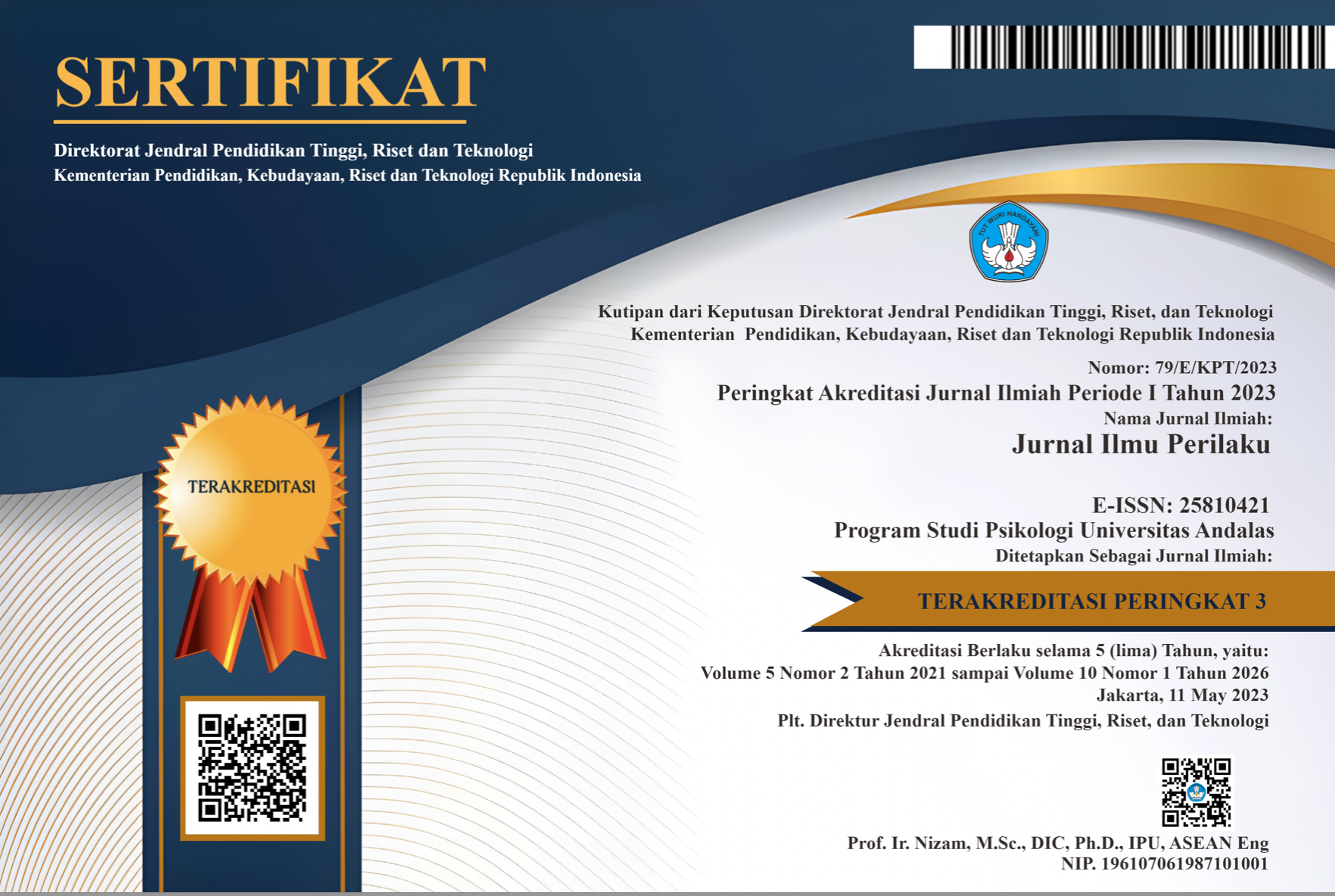Kepuasan Pernikahan Berhubungan dengan Kecenderungan Berselingkuh
Abstract
The purpose of this study is to find out the relationship between marital satisfaction and tendency in infidelity among husbands and wives who live in Jabodetabek. The samples of this research are 43 males and 41 females between the ages of 27 and 56 years. The datas were analized using pearson correlation. The results showed that there are a relationship between marital satisfaction and emotional, and emotional physical infidelity. Interpersonal relationship, mutual interest, congruency between role and hope, relationship with in laws, and power and attitudes toward marriage are the domains of marital satisfaction which have a significant relationship with emotional infidelity. The domains mutual interest, relationship with in laws, and power and attitudes toward marriage found have a significant relationship with emostional physical infidelity. Among all those domains, relationship with in laws has more contribution affected tendency in infidelity.
Downloads
References
Kompas. (2008, 15 Juli). Sepuluh persen perkawinan berakhir perceraian. Diunduh darihttp://female.kompas.com/read/xml/2008/07/15/19574987/sepuluh.persen.perkawinan.berakhir.perceraian.
Bird, G. & Melville, K. (1994). Families and Intimate Relationships. London: McGraw Hill, Inc
Buss, D. M., & Shackelford, T.K. (1997). Susceptibility to infidelity in the first year of marriage. Journal of Research in Personality, 31, 193–221.
Clarke-Stewart, A., & Brentano, C. (2006). Divorce: Causes and consequences. New Haven and London: Yale University Press.
Drigotas, Stephen M, & Barta, William. (2001). The Cheating Heart: Scientific Explorations of Infidelity. Journal Psychological Science. Vol. 10 177-180.
Drigotas, S.M., Safstrom, C.A., & Gentilia, T. (1999). An investment model prediction of dating infidelity. Journal of Personality and Social Psychology, 77(3) 509-524.
Duffy, K.G., & Atwater, E. (2005). Psychology for living: Adjusment, growth, and behavior, 8th Ed. New Jersey : Pearson Prentice Hall.
Duvall, E.M., & Miller, B. C. (1985). Marriage and Family Development. New York, Harper & Row
Fitzpatrick, M. A. (1988). Between husbands and wives: Communication in marriage. Newbury Park, CA: Sage.
Glass, S.P & Wright, T.L. (1977). The Relationship of extramarital sex, length of marriage and sex differences in marital satisfaction and romanticism. Journal of Marriage and Family. 39. 691-703.
Glass, S.P & Wright, T.L. (1992). Justification for extramarital relationships: The association between attitudes, behaviors, and gender. Jornal of Sex Research. 29. 361-387.
Herfianti, Fitri. (2005). Inventori Kepuasan Pernikahan. Depok: Tugas Akhir Profesi Klinis Dewasa Fakultas Psikologi Universitas Indonesia.
Madathil, J. & Sandhu, D.S. (2008) Infidelity in Asian Indian marriages: Implications for counseling and psychotherapy. The Family Journal. 16, 338. Diunduh dari http://tfj.sagepub.com/cgi/content/abstract/16/4/338.
Mazza, T Marisa. (2009). Justification of Infidelity: Self Reported Factors that Lead to Infudelity. San Fransisco: A dissertation: The California School of Professional Psychology.
McAnulty, R.D & Brineman, M.J. (2007). Infidelity in Dating Relationships. Journal Annual Review of Sex Research. 18. 94-114.
Papalia, D.E., & Olds, S.W. (2001). Human Development 8th Edition. New York: McGraw Hill.
Patterson,J., Hayworth, M., Turner, C., & Raskin, M. (2000). Spiritual Issues in Family Therapy: A graduate level course. Journal of Marital and Family Therapy. 26.
199-210.
Perl, S. (2008). Marital satisfaction. Disseration. Florica: Faculty of The American of Clinical Sexologists Maimonides University.
Peluso, Paul. R. (2006). Infidelity: A Practitioner’s Guide to Working with Couples in Crisis. New York: Taylor & Francis Group, LLC.
Pimentel, E, Effron. (2000). Just How Do I Love Thee?:Marital Relations in Urban Chine. Jurnal of Marriage and Family, 62, 32-47.
Pinsof, W.M., & Lebow, J. (2005). Family Psychology: The art of the science. New York: Oxford University Press.
Ponzetti, J. (2003). International encyclopedia of marriage and family Volume 1 2nd Ed. New York: Macmillan Reference USA.
Olson, D.H., & DeFrain, J. (2006). Marriages and families: Intimacy, diversity, and strengths. 5th ed. New York: McGraw Hill.
Rini, J.F. (2001). Perselingkuhan untuk memenuhi kebutuhan seksual. Diunduh dari http://www.e-psikologi.com/epsi /search.asp/ pada 29 Agustus 2009.
Satiadarma, M. P. (2001). Menyikapi perselingkuhan. Jakarta: Pustaka Populer Obor.
Seccombe, K., & Warner, R. L. (2004). Marriages and Families : Relationship in social context. Belmont, CA: Wodsworth/Thompson.
Subtonik, R.B., & Haris, G. (2005). Surviving Infidelity : Making decisions, recovering from the pain (3rd ed.). Cincinnati, OH: Adams Media
Suitor, J.J. (1991). Marital Quality and Satisfaction with the Division of Haousehold Labor across the Family Life Cycle. Journal of Marriage and Family. 53. 221-230.
Williams, Brian, K; Sawyer, Stacey C., Wahlstorm, Carl M. (2006). Marriages, Families, and Intimate Relationships: A Practical Introduction. Boston: Pearson Education Inc.
Zastrow, C., & Kirst-Ashman, K. (2001). Understanding human behavior and the social environment. Chichago: Nelson Hall
The non-commercial use of the article is governed by the Creative Commons Attribution license as currently displayed on Creative Commons Attribution-NonCommercial-ShareAlike 4.0 International License.
JIP's spirit is to disseminate articles published are as free as possible. Under the Creative Commons license, JIP permits users to copy, distribute, display, and perform the work for non-commercial purposes only. Users will also need to attribute authors and JIP on distributing works in the journal.
Please find the rights and licenses in Jurnal Ilmu Perilaku (JIP).
- License
The non-commercial use of the article will be governed by the Creative Commons Attribution license as currently displayed on Creative Commons Attribution-NonCommercial-ShareAlike 4.0 International License.
- Author’s Warranties
The author warrants that the article is original, written by stated author(s), has not been published before, contains no unlawful statements, does not infringe the rights of others, is subject to copyright that is vested exclusively in the author and free of any third party rights, and that any necessary written permissions to quote from other sources have been obtained by the author(s).
- User Rights
JIP's spirit is to disseminate articles published are as free as possible. Under the Creative Commons license, JIP permits users to copy, distribute, display, and perform the work for non-commercial purposes only. Users will also need to attribute authors and JIP on distributing works in the journal.
- Rights of Authors
Authors retain the following rights:
- Copyright, and other proprietary rights relating to the article, such as patent rights,
- The right to use the substance of the article in future own works, including lectures and books,
- The right to reproduce the article for own purposes, provided the copies are not offered for sale,
- The right to self-archive the article.
- Co-Authorship
If the article was jointly prepared by other authors, the signatory of this form warrants that he/she has been authorized by all co-authors to sign this agreement on their behalf, and agrees to inform his/her co-authors of the terms of this agreement.
- Termination
This agreement can be terminated by the author or JIP upon two months’ notice where the other party has materially breached this agreement and failed to remedy such breach within a month of being given the terminating party’s notice requesting such breach to be remedied. No breach or violation of this agreement will cause this agreement or any license granted in it to terminate automatically or affect the definition of JIP.
- Royalties
This agreement entitles the author to no royalties or other fees. To such extent as legally permissible, the author waives his or her right to collect royalties relative to the article in respect of any use of the article by JIP or its sublicensee.
- Miscellaneous
JIP will publish the article (or have it published) in the journal if the article’s editorial process is successfully completed and JIP or its sublicensee has become obligated to have the article published. JIP may conform the article to a style of punctuation, spelling, capitalization, referencing and usage that it deems appropriate. The author acknowledges that the article may be published so that it will be publicly accessible and such access will be free of charge for the readers.










